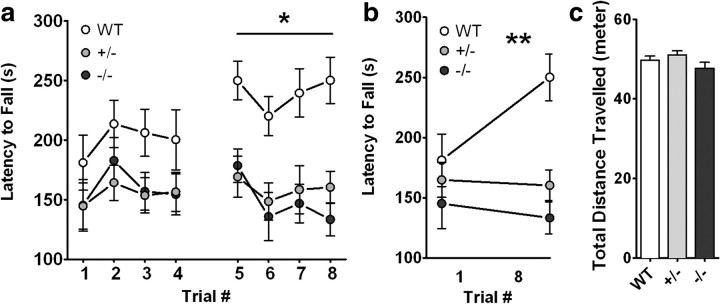Figure 2.
a–c, CX3CR1−/− and CX3CR1+/− mice show motor learning impairment but normal spontaneous activity. a, On the first day of training (Trials 1–4) no difference between genotypes was observed in the learning ability in the rotarod task. On the second day of training (Trials 5–8) as expected, wild-type mice learned the rotarod task as demonstrated by their ability to remain on the rod for longer periods. Neither the CX3CR1−/− nor the CX3CR1+/− mice showed significant improvement in motor coordination with training when compared to wild-type (repeated-measure ANOVA; p < 0.0001). White circles, WT; gray circles, CX3CR1+/−; black circles, CX3CR1−/−. All data are presented as mean ± SEM. *p < 0.01. b, Comparison of the motor performance of each group of mice on Trial 1 versus Trial 8 shows that wild-type performed significantly better than CX3CR1−/− and CX3CR1+/− mice (linear regression; **p < 0.001). c, CX3CR −/− and CX3CR1+/− mice show normal spontaneous locomotor activity. Wild-type, CX3CR1−/− and CX3CR1+/− mice do not show any difference in total distance traveled in the open field. White bar, WT; gray bar, CX3CR1+/−; black bar, CX3CR1−/−. All data are presented as mean ± SEM.

